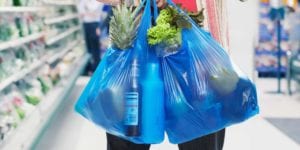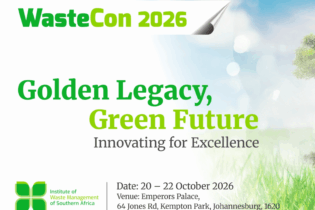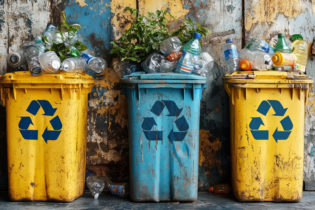Researchers from the International Marine Litter Research Unit at Plymouth University in the United Kingdom have published new research in Environmental Science and Technology showing that biodegradable bags can hold a full load of shopping three years after being discarded in the environment.
The team, under the guidance of Unit Head, Professor Richard Thompson OBE, had examined the degradation of different plastic bags widely available from retailers including compostable bags, two forms of biodegradable bag and conventional carrier bags. These were left exposed to air, soil and sea – environments which they could potentially encounter if discarded as litter – and monitored at regular intervals. Deterioration was considered in terms of visible loss in surface area and disintegration as well as assessments of more subtle changes in tensile strength, surface texture and chemical structure. After nine months in the open air, all the materials had completely disintegrated into fragments. The compostable bag completely disappeared from the experimental test rig in the marine environment within three months but, while showing some signs of deterioration, was still present in soil after 27 months. But, the big shock was that the biodegradable, oxo-biodegradable and conventional plastic formulations remained functional as carrier bags after being in the soil or the marine environment for over three years. The research team said their results raise several questions, including whether environmental and weather conditions are a realistic means of decomposing bags when they are thrown away, even if they are labelled as ‘biodegradable’. Important, too, is the confusion of the use of the term ‘biodegradable’; the researchers believe it lulls consumers into thinking the bag will simply disappear if thrown away. Further, if consumers think they are being even more responsible by adding biodegradable bags to their recycling bins, that can destroy efforts to collect conventional plastic bags for remanufacture into new bags, they warn. Chemical additives in biodegradable bags can contaminate the mixture, rendering it unusable. Both the United Nations and the European Union have declared that biodegradable plastics are not the answer to marine plastic pollution while the EU has recommended banning oxo-biodegradables (plastics which contain additives designed to hasten breakdown of polymer molecules) because that process causes the bag to disintegrate into small microplastics, raising levels of which are also of great concern. These issues and more are top-of-mind for South African National Bottled Water Association CEO Charlotte Metcalf, whose members package either in glass of PET bottles.“Obviously, bags are not bottles, nor are the plastics used to make the two the same,” she said
“But SANBWA and its members are very conscious of the global backlash against plastics of all kinds, because of the negative impact it can have on our industry. “Despite the fact that, in South Africa, the total bottled water industry amounts to just 543.7 million litres a year versus the 5 668,7 billion litre a year fizzy drink, iced teas and energy drink market1, bottled water as a product has become the ‘whipping boy’ when it comes to PET and packaged beverages. “Of course, plastic in all its forms is one of the major pollutants of our water bodies and landmasses. Ways must be found to curtail that pollution but calls for outright bans, or the adoption of unproven and untested alternatives are grossly overrated as solutions. As this most recent research highlights, often what seem to be logical choices, can only make the situation worse. Or raise more questions than answers.” Metcalf pointed to an exciting new technology called biotransformation by way of example. “Mooted by Polymateria as a new approach to ensuring that plastic which has escaped refuse streams can fully biodegrade in the natural environment, the idea of biotransformation does ‘float my boat!’,” she said. “However, it does rely on a proprietary formulation lying dormant until, ‘with the agreed timing, the formulation gets to work by triggering a catalytic process that actively targets the crystalline regions within polymer chains to radically cleave them apart.’ “The implications of this ‘agreed timing’ – read ‘agreed shelf life’ – are far-reaching because that timing can differ radically given the product, and the packaging format. Just as yoghurt is a very different product to a tomato destined to be canned, so is a yoghurt tub a very different package to a PET-line tin of tomatoes, for example. “In addition, as mentioned above, would this product – if added to the conventional plastics recycling stream – contaminate the mixture and render it useless, meaning that the whole batch goes to landfill? “It really is time to find truth and balance in the myriad calls for plastics to be replaced with alternatives or degradable versions. A holistic strategy that results in investing in solutions that most importantly encourage behaviour change coupled with the implementation of considered, well-thought through new technologies is much closer to the answer,” Metcalf said. “SANBWA works closely with industry and PETCO to ensure its members’ packaging commits to design for recycling criteria so that each bottle can be fully recycled. Members also support clean-ups, such as those run by PlasticsSA.”







